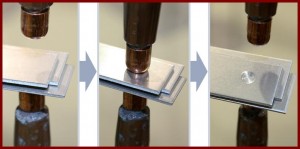
GM says that spot welding aluminum body structures and closures gives it a unique manufacturing advantage.
General Motors Research & Development has invented what it claims is an industry-first aluminum welding technology, which it predicts will increase the use of the lightweight metal on future vehicles. The latest fuel economy regulations are forcing automakers to improve efficiency. Simple Newtonian physics explains that the force needed to accelerate a mass decreases with weight reduction, for example, less fuel is needed to move a lighter vehicle – if the weight reduction is not used to increase performance, a traditional industry response.
GM’s new aluminum spot welding process uses a patented “multi-ring domed electrode” that does what smooth electrodes cannot – reliably weld aluminum to aluminum. By using this process, GM expects to eliminate nearly two pounds of rivets from aluminum body parts such as hoods, liftgates and doors.
There are already limited production applications of aluminum spot welding, including the Cadillac CTS-V and the liftgate of the hybrid versions of Chevrolet Tahoe and GMC Yukon. GM says it plans to use this technology more extensively starting in 2013.
“This new technology solves the long-standing problem of spot welding aluminum, which is how all manufacturers have welded steel parts together for decades,” said Jon Lauckner, GM chief technology officer and vice buy lorazepam online president of Global R&D. GM’s new welding technique works on sheet, extruded and cast aluminum because a multi-ring domed electrode head disrupts the oxide on aluminum’s surface to enable a stronger weld.
Traditional spot welding uses two opposing electrode “pincers” to compress and fuse pieces of metal together, with an electrical current creating intense heat to form a weld. The process is inexpensive, fast and reliable, and therefore in widespread industrial use, but it did not work on aluminum. Automakers have used self-piercing rivets to join aluminum body parts because of variability in production with conventional resistance spot welding. However, rivets add cost and riveting guns have a limited range of joint configurations. In addition, end-of-life recycling of aluminum parts containing rivets is more complex.
Aluminum offers advantages over steel but it is more expensive. One kilogram of aluminum can replace two kilograms of steel in some design studies. It is corrosion-resistant and offers an excellent blend of strength and low mass that can help improve fuel economy and performance. Potentially a 5 % – 7 % fuel savings is available for a 10% reduction in weight. Substituting lightweight aluminum for a heavier material is one way to do it. According to Ducker Worldwide, a Michigan-based market research firm, aluminum use in vehicles is expected to double by 2025.

